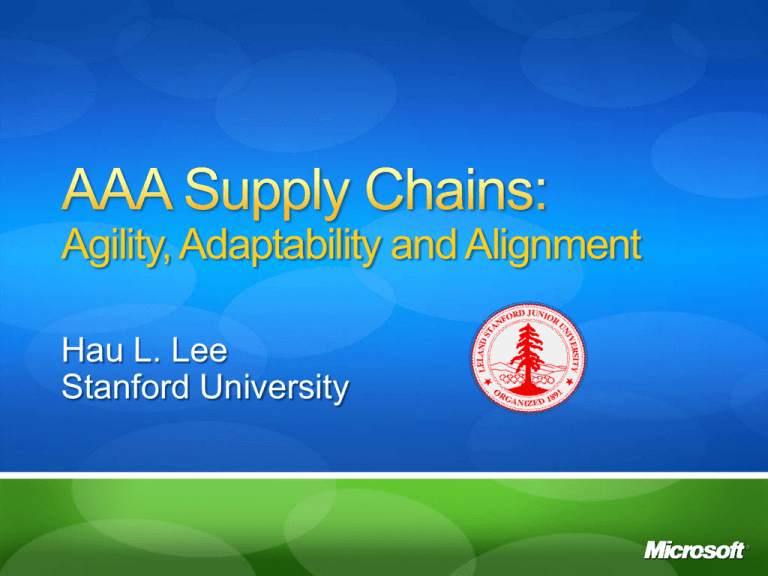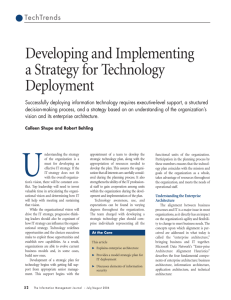
Agility, Adaptability and Alignment
Hau L. Lee
Stanford University
Demand
and supply
uncertainties
Fashion like product
Strong competitive forces
Increasing product variety
Potential of external disruptions
Short product
and technology
cycles
Fast changing hardware and software
Multiple sources of technological advances
Frequent product transitions
Manufacturing cost pressures
Multiple supply
chain partners
Outsourced manufacturing partners
Outsourced design partners
Consumer electronics channel
Other associated product providers
Challenges
Implications
Increasing demand and
supply uncertainties
Uncertainty drives
need for flexibility
Shortening product and
technology cycles
Dynamic instead of
static supply chains
Multiple outsourced
supply chain partners
Differential interests
of multiple players
Challenges
Implications
Increasing demand and
supply uncertainties
Uncertainty drives
need for flexibility
Shortening product and
technology cycles
Dynamic instead of
static supply chains
Multiple outsourced
supply chain partners
Differential interests
of multiple players
Agility
Adaptability
Alignment
Challenges
Implications
Increasing demand and
supply uncertainties
Uncertainty drives
need for flexibility
Shortening product and
technology cycles
Dynamic instead of
static supply chains
Multiple outsourced
supply chain partners
Differential interests
of multiple players
Agility
Adaptability
Alignment
Largest convenience
store chain in Japan
($23.3B annual sales)
with 10,853 outlets
(1,200 sq. ft each)
#1 in fast foods
#1 in battery,
ladies stocking sales
#2 in paperback/
magazine sales
Value of $1 Investment
SEJ
Nikkei
55 Inventory turns/year
Year
Multimedia
distribution
Multimedia
distribution
Multimedia
Host
transmission
computer
7-11
Japan
HQ
Satellite
center
Dedicated
line
Store
ISDN
Network
Combined
distribution
center
7-11 Japan
district office
Manufacturer
OFC mobile
computer
Trust-based agile logistics
Dynamic shelving
Supplier collaborations
Measure
Act
Localized promotions
Shelf & merchandizing
New product development
POS+
Total visibility
Identify
Analyze
Correlation and
Substitution Local events
Product transitions
General Design
Strategic Sourcing
Marketing & Distribution
New product release data
General design changes
Mechanical design data
Mfg. Design changes
Sourcing changes
Mechanical Design
Plastics
Component
Procurement
PCBA Mfg.
Testing
System Build & Test
Final Packaging
Chip design data
Chip design changes
California
Texas
Chip Design (GPU & MCP)
Chip Supply
Mexico
Hungary
2001 Product launch in 14 months (versus
20 months for Sony Playstation 2), winning
3.6% market share in 4 months.
Chip Packaging
Chip Design (GPU &
MCP)
Chip Design
Transportation
customs
clearance
3rd Source
Manufacturing
2nd Source
Manufacturing
Mechanical Design
Services
Procure Components
Plastics
PCBA Mfg.
Testing
Final Packaging
In November and December 2005, Xbox launched Xbox 360
simultaneously in N America and Europe,
beating Sony’s Playstation 3 by close to a year.
Product postponement:
field-programmable integrated circuits
Process postponement: die-bank as
decoupling point and customize to order.
IRL (Internet-Reconfigurable Logic) allows
reconfiguration remotely via the Internet
Postponement strategy supports NPI and
upgrades
Number 1 market leader
Wafer fabrication
Die-bank
FA&T
Wall Street Journal, January 29, 2001
March 17, 2000,
lightning-induced
fire at Philips’
radio-frequency
chips factory in
Albuquerque,
New Mexico
Percent of Respondents
, Agree, 37
, Strongly
Agree, 11
, Neutral, 37
, Disagree, 11
, Strongly
Disagree, 5
Based on a Stanford study on Driving Business Value through B2B Outsourcing, supported by GXS, 2007
Percent of trading partners integrated via B2B solutions
Before
outsourcing
After
outsourcing
Based on a Stanford study on Driving Business Value through B2B Outsourcing, supported by GXS, 2007
Average Percent
Improvement
Based on a Stanford study on Driving Business Value through B2B Outsourcing, supported by GXS, 2007
“Sensible” Sense
“Responsive”
Response
Deep Intelligence
Efficient Execution
Local Empowerment
Decentralized Control
Integrated Information Systems –
Centralized Command
Challenges
Implications
Increasing demand and
supply uncertainties
Uncertainty drives
need for flexibility
Shortening product and
technology cycles
Dynamic instead of
static supply chains
Multiple outsourced
supply chain partners
Differential interests
of multiple players
Agility
Adaptability
Alignment
80’-90’
Complex technology with
Lucent as leader
Primary market
in North America
Supply base in Asia
not well developed
Oklahoma City as central
procurement, stocking, kitting
and assembly site for North
America and Asia.
91’-00’
Response time a
competitive pressure
Fast growing
market in Asia
Bulk of supply
base in Asia
1996: Taiwan and Qingdao as
engineering, procurement and
final assembly hub for Asia,
backed up by OKC.
Technology
Market
Focus
Strategy
Leadership
Concentrated
supply/demand
Margin
and control
Centralization
Maturity
Regionally
distributed
supply/demand
Responsiveness
Expanded
network
Decline
Globally
distributed
supply/demand
Agility
Value
chain redesign
2000
5*
No. of plants
29
5*
No. of suppliers
3,000
900
No. of enclosures
47
7
Inventory turn
1
6-7
Heavy losses
Profitable for 4
consecutive
quarters
Profitability
*24 plants were sold off or closed. Celestica, Jabil,
Sanmina and Solectron now handle 95% of total production needs
Fortune 2003
2005
Sales
($B)
Profit
(%)
Arcelo
r
40.57
13
Mittal
28.13
12
JFE
24.37
12
NSC
22.93
9
POSC
O
21.42
18
POSCO
S&P500
NYSE (February ‘04 to January ‘07)
Iron Ore
Blast Furnace
(Remove
Oxygen
& Impurities)
Residual
Crude (Pig)
Carbon
Iron
Removal, Other
Alloys Added
Liquid Steel
Casting
Slab
Ingots
Reheating
Ingots
Continuous casting to save energy
Factory layout to cut cycle time
from days to hours
Real time production control
Innovative FINEX process
Source of national pride
Rollin
g
Rolled wires,
plates, pipes
Steel consumption (tons/person)
US
China
Projected worldwide
steel shortage
In 2004-2005
Iron ore cost
rose by 20%
Coking coal cost
rose by 80%
Freight cost
rose significantly
Increasing pressures
of trade barriers
Crude steel manufacturing near iron ore
mines; finishing plants near customers.
Iron Ore
Supply
JV and
strategic
alliances
with iron ore
suppliers in
India, Brazil
and Australia
Crude
Steel
Production
Slabs
Plans to build
crude steel plants
in Brazil
12 M-ton steel
plant ($12B) in
Orissa, India;
Phase I by Dec
2010 with
investment of
$3.7B
Finishing
Plants
JV with US Steel in 2002 on
finishing plant in Pittsburgh
Thailand: Cold Roll plant for
Auto steel sheets (1/06)
Nagoya, Japan: Cold Roll
plant for Auto (2/06)
Kunsan China: Cold Roll
plant for Auto (02/04)
Maharashtra, India: Plant for
Electrical steel sheet (11/05)
Flexible Network
Relationships
People-ready
Change Mgmt
Architect Supply Chain for Right
Product, Market & Time
Market
Intelligence
Product PLC
Needs
Technology
Evolution
Challenges
Implications
Increasing demand and
supply uncertainties
Uncertainty drives
need for flexibility
Shortening product and
technology cycles
Dynamic instead of
static supply chains
Multiple outsourced
supply chain partners
Differential interests
of multiple players
Agility
Adaptability
Alignment
“The weakest link of the supply
chain defines the supply chain.”
“Instead of company to company
competition, we are now in an era of
supply chain to supply chain competition.”
“Win-win relationship is the
cornerstone of supply chain success.”
Inventory
Toyota
Distribution
Dealers
Inventory risk
Facility
Investment
Inventory
Toyota
Distribution
Inventor
Risk
Dealers
Facility
Investment
Organizational Boundary
Dimension
Single
Enterprise
Single
Dimensional
MultiDimensional
CrossEnterprise
Time from landing
to departure
Transit time
What about time from landing to destination?
Dimension
Alignment
Decisions, roles,
responsibilities
Re-assignment
and empowerment
Risks, costs, rewards
Adjusted for incentives
with win-win interests
Performance measures
Extended, joint, stretched
to reflect alignment
Empowerment of decisions
and responsibilities requires
provision of capabilities
Alignment ultimately
demands behavioral change
Successful alignment across organizations
is based on building trust in a supply chain
Average Percent Improvement
Based on a Stanford study on Driving Business Value through B2B Outsourcing, supported by GXS, 2007
US$M
2005 sales: US$8.2B (7.5% YoY
G.R.)
1995 – 2005 CAGR: 22.4%
Q1
Source: TSMC
Q2
Q3
Q4
World’s largest foundry
(contract semiconductor
fabrication manufacturer)
Emphasizes customer
relationship as
“First and Last Look”
Invests in E-SCM to help
internal and customers’
supply chain process
eFoundry
Design collaboration
Engineering collaboration
Logistics collaboration
E-SCM Architecture
Demand
Planning
Allocation
Planning
Capacity
Modeling
Allocation
Management
Order
Management
Available
ToPromise
Output
Planning
Iterative design verification and improvement process
Sharing common mask set with different chips
Diamond lane treatment
Great cost and time savings for customers
Helps customers NPI
Win for both TSMC and customers
TSMC Solution
Service
Focus
Technology
Focus
Customer-centric
total solution
Manufacturing
Focus
Schedule
ahead of ITRS
Web-based design
engineering and
logistic service
Capacity
Leadership
Complete SoC
portfolio
Comprehensive
design service
Production
Excellence
World-class quality
Integrated
backend service
1987
1997
2000
Agility
Adaptability
Alignment
Extensive information integration
Optimization-based applications
Highly efficient manufacturing processes
Centralized command, decentralized control
Fab expansion based on technology
and market changes
Evolution to service-focus business
Optimized product/fab assignment
Information sharing across supply chain
Collaborative relationships with customers
Tight connectivity with assembly and test
Trust-based, people-oriented organization
“Sensible” Sense
“Responsive”
Response
Deep Intelligence
Efficient Execution
Local Empowerment
Decentralized Control
Integrated Information Systems –
Centralized Command
Flexible Network
Relationships
People-ready
Change Mgmt
Architect Supply Chain for Right
Product, Market & Time
Market
Intelligence
Product PLC
Needs
Technology
Evolution
Dimension
Alignment
Decisions, roles,
responsibilities
Assignment to best run
overall supply chain
Risks, costs, rewards
Adjusted for incentives
with win-win interests
Performance measures
Extended, joint, stretched
to reflect alignment
World class supply chains require
capabilities in agility, adaptability and
alignment
Sensible Sense and Responsive
Response to gain agility
Right supply chain for the
right product and right time
Winning with the whole supply chain
AAA supply chain management is the key
for super-AAA performance and values
© 2007 Microsoft Corporation. All rights reserved. Microsoft, Windows, Windows Vista and other product names are or may be registered trademarks and/or trademarks in the U.S. and/or other countries.
The information herein is for informational purposes only and represents the current view of Microsoft Corporation as of the date of this presentation. Because Microsoft must respond to changing market
conditions, it should not be interpreted to be a commitment on the part of Microsoft, and Microsoft cannot guarantee the accuracy of any information provided after the date of this presentation.
MICROSOFT MAKES NO WARRANTIES, EXPRESS, IMPLIED OR STATUTORY, AS TO THE INFORMATION IN THIS PRESENTATION.


